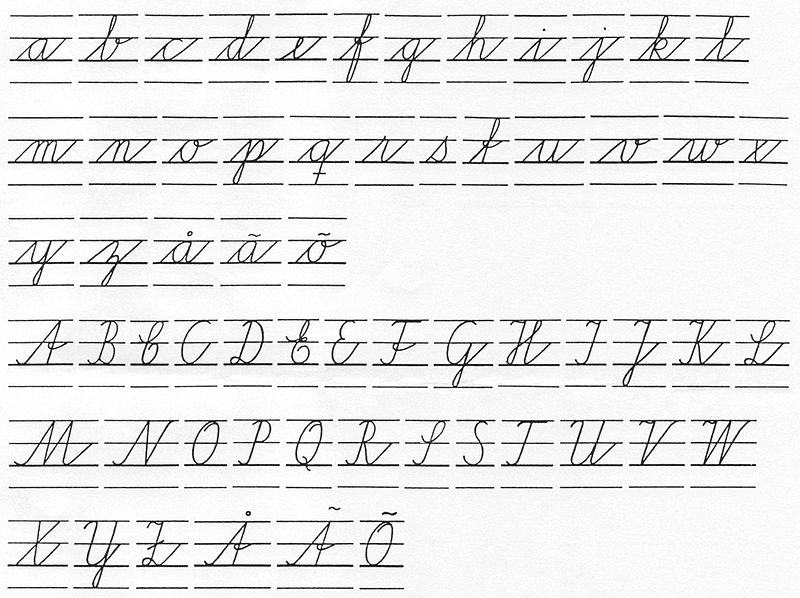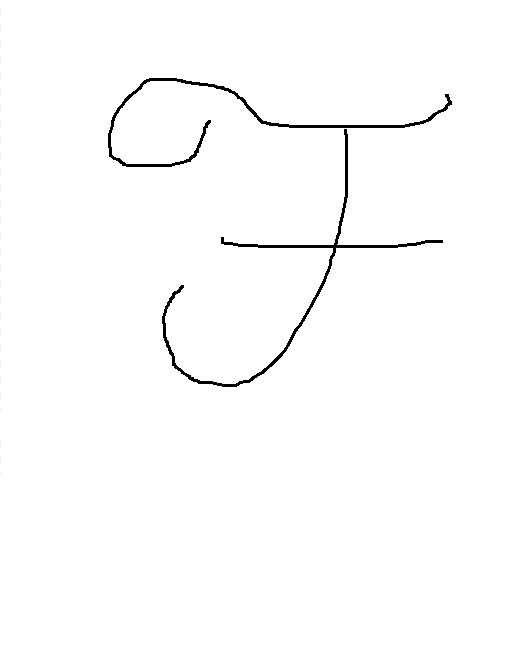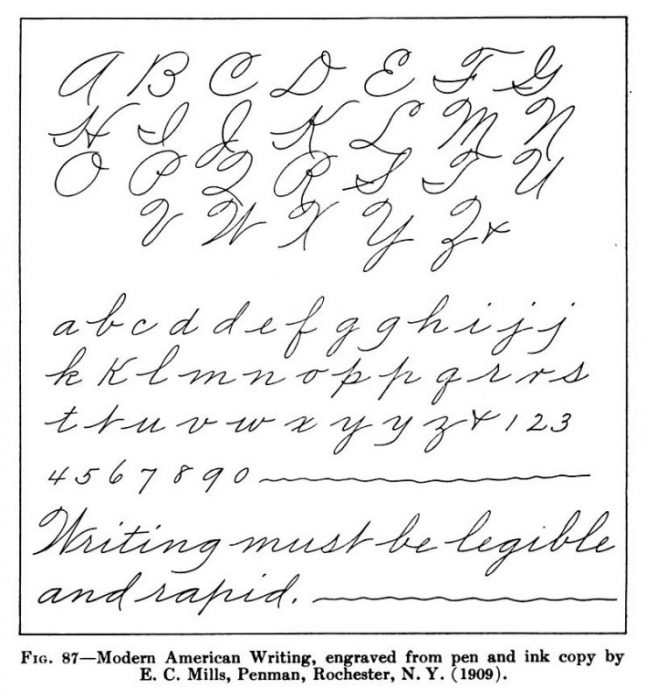
Are you interested in learning how to write a cursive capital F? You can read on to learn how to write a cursive capital F, as well as to learn some interesting facts about cursive as a whole.

Photo: My Own
A cursive capital F can be written by following these steps:
First, begin by choosing a point near the top of your line that you will be writing on. Start by drawing a loop down and to the left, then follow by quickly pulling the loop back up and to the right. You will then take this line down slightly and then back up as it moves towards the right. Roughly in the middle of this line you just drew, draw a line heading downwards and to the left, drawing the bottom of the curve heading out and to the left. The arc should be swinging out to the left and then pushing back right. Finally, draw a short line across the middle of the F’s column.
History Of Cursive
Cursive is sometimes called longhand or script, in contrast to print, which is the form of letters you are reading right now – letters not linked together. The typical rationale for writing in cursive is that it makes the writing of letters faster and easier. Because letters are joined together in cursive, there is increased flow to the letters compared to printing. This style nullifies the need to make as many spaces in between letters, cutting down on the number of times that you lift your writing tool and making the writing faster overall. Some variations of cursive include more lifts or spaces, but most forms of cursive feature letters that are joined together. Subtypes of cursive include ligature, italic cursive, and looped cursive.
The word cursive is believed to come from medieval Latin, being derived from the word “corsivo”. Corsivo approximately translates to “running” or “to run”. The history of cursive writing is long and complicated because different societies have utilized some type of connected letter system throughout human history. For instance, the Romans used some form of connected script and did the Arabic writing system. The origins of English cursive as we know it can be traced to Western Europe and during the late 16th century to mid-17th century, while cursive wasn’t standardized at this point, the use of cursive did begin during this time. During the mid-17th century, cursive spread across the British Empire, and the latter half of the 17th and 18th centuries saw cursive become even more popular and standardized. The United States has used some form of cursive since the days of the American colonies, and the type of cursive used today isn’t that different from the cursive used in the US during the middle of the 19th century.

Photo: John Mason Neale, URL: https://en.wikipedia.org/wiki/File:Looped_cursive_sample.jpg, Public Domain
As previously mentioned, there are different types of cursive – looped cursive, ligature cursive, and italic cursive. Ligature cursive is a type of cursive which connects the ending and beginning letters of words together with lines, and as a result, the writer has to pick up their writing tool less frequently. While ligatures are common in typefaces, handwriting tends to use them less frequently, with certain ligature cursives being exceptions. Italic cursive is a form of cursive which has very few looped joins, with there being few to no joins between the letters Y, G, J, or Q. A few other joins are discouraged though sometimes used. Italic cursive is not slanted, though you may be tempted to that assume due to the fact that italics in typeface referred to be slanting of the letters. However, the term italic cursive actually comes from the fact that Renaissance Italy used this type of cursive writing. Finally, looped cursive is the standard cursive, the type of cursive most people think of when they hear the word cursive. The ascenders and descenders in cursive have unique loops and joins that bridge letters together and make writing faster.
The use of cursive has continuously been impacted by advancements in technology. One of the technological investments that led to the decline of cursive handwriting was the ballpoint pen. Cursive writing made writing with ink quills easier, thanks to the joining of letters which negated the need to dip the ink quills as often. However, as ballpoint pens became cheaper and more ubiquitous, and inkless prone to smudging was produced, cursive necessity began to decline. The invention of the typewriter and later the keyboard and the computer also pushed the decline of cursive.
Should We Still Teach Cursive?
Schools across the United States began to mandate the teaching cursive in the late 50s and early 60s. However, in the 21st century, many find cursive to be on unnecessary skill and the teaching of it a waste of instruction time. Many school districts and teachers have chosen to forego teaching cursive, and cursive is considered to be a dying art by many. As an example of cursive’s perceived decline, while in 2007 around half of the second graders and 90% of third graders were taught cursive, only about 15% of students at the same time wrote the answers to their SAT in cursive. In the decade since those studies, digital communication has only continued to become cheaper and easier, with smartphones and computers becoming ever more prolific. As a result, states like Hawaii and Indiana are no longer mandating the teaching of cursive in their school curriculums, focusing on keyboard proficiency instead.

Photo: By Edward C. Mills – Questioned documents by Osborn, Albert Sherman 1910, Chapter XI Systems of Writing and Questioned Documents, page 178, Public Domain, https://commons.wikimedia.org/w/index.php?curid=54886243
Despite the decline in usage of cursive during the 21st century, many teachers, scientists, and historians argue that it is still important to preserve cursive. Many important historical documents are written in cursive, and the inability to read cursive means that it would be difficult for historians who have not learned it to read documents in their original, untranslated form. However, while historians may have utility for learning cursive, the debate around the necessity of teaching cursive to students rages on. In general, school districts in the United States seem to be reducing the amount of time spent on cursive, if not removing it from curriculums entirely.
Since 2010, 45 different states across the United States have accepted the common core standards of education as part of their education outline. These common core standards leave it up to individual states to make determinations about the teaching of cursive, and many states have chosen to drop cursive from their curriculums. A report done by the Miami-Dade public school system found that the number of schools teaching cursive has declined across the country since the 1970s. The decline in cursive has also been seen in other countries, such as Finland.
While cursive has declined in popularity, some teachers, school boards, and parents have argued for the preservation of cursive in school curriculums, saying that in cursive helps develop clear, legible handwriting in general. Learning cursive, it is argued, not only helps students develop better handwriting, but assists them in reading and writing faster by enhancing their language skills and their understanding of the material. Studies have compared students who take notes by hand to students who take notes on a laptop tablet or other digital device. These studies seem to imply that people who take notes by hand have a better understanding and factual recall of material. Despite this, it isn’t clear that writing in cursive is what is responsible for the improved comprehension and recall. It’s possible that simply physically writing something down, no matter the format it is written down in, improves recall and understanding.
Arguments against keeping cursive in school curriculums challenge the idea that writing in cursive improves cognition/enhances understanding of the material, as it could be that these perceived benefits are a manifestation of confirmation bias – the attribution of perceived benefits in cognition or motor skills to cursive, simply because cursive looks better.
Other criticisms of teaching cursive argue that studies which have attributed various cognitive benefits to cursive have been either misinterpreted or misrepresented.
On the other hand, there is some evidence that suggests the teaching cursive could actually help teach students to write and read better. Students with disabilities may particularly benefit from learning cursive, as research suggests that learning cursive could help students with dyslexia manage their condition.
No matter how you feel about the teaching of cursive in school curriculums, if you want to get better at writing cursive, the only way to get better is by practicing. You can start out practicing cursive by obtaining a list of cursive letters. Go through the letters one by one and practice them daily, until you are proficient in writing cursive. At this point, you should be able to easily join the letters together and remember what the various cursive letters look like. Practice will help you refine your penmanship and your recall of the letters.








